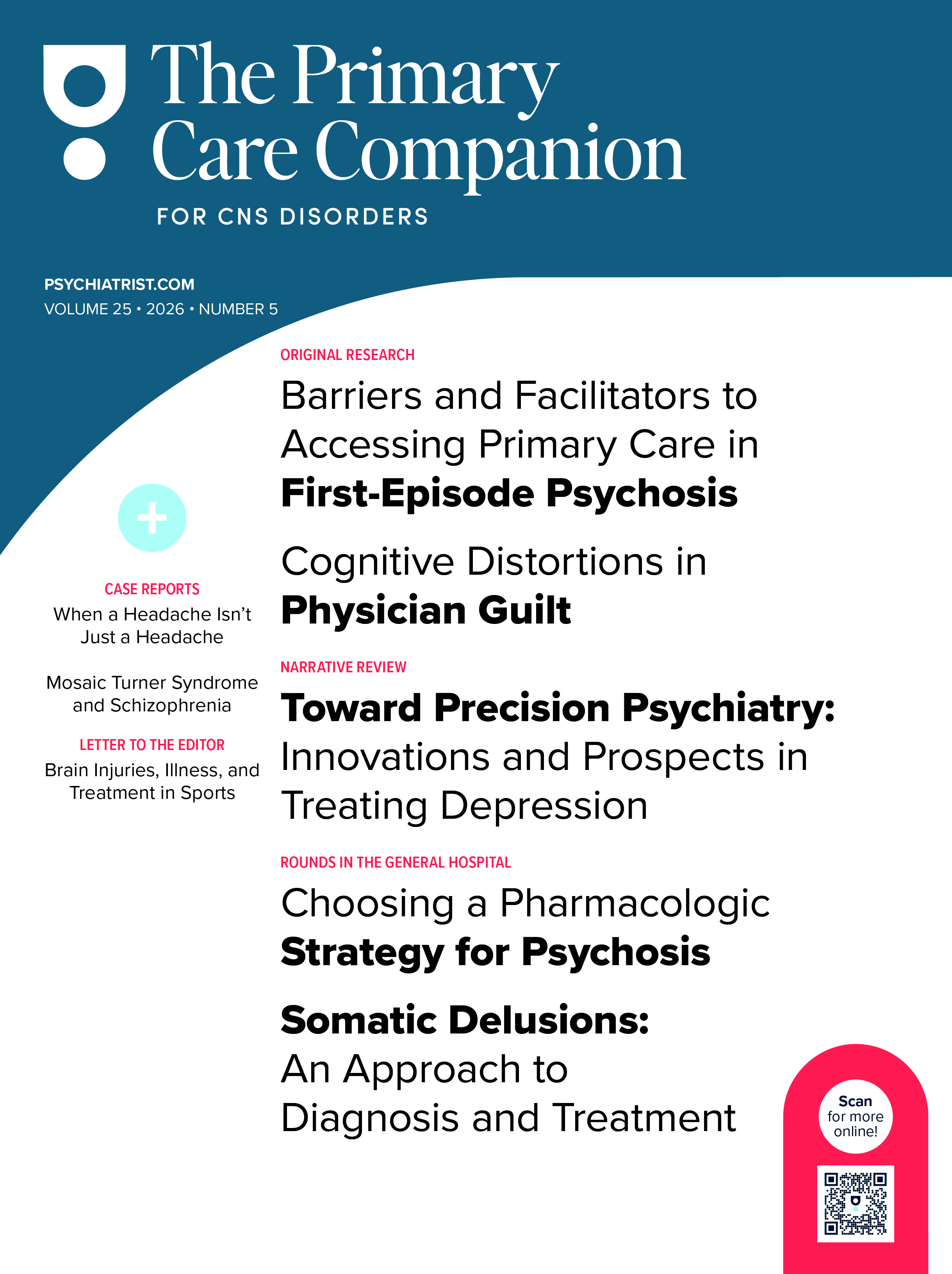Oculogyric crisis (OGC) is an extrapyramidal symptom (EPS) characterized by an acute dystonic reaction with involuntary upward eye deviations, typically induced by dopamine D2 receptor antagonists such as antipsychotics. However, similar ocular movements may result from postencephalitic parkinsonism, epileptic seizures, paroxysmal tonic upgaze syndrome, or ocular tics,1 posing diagnostic challenges.2–4 Clozapine’s weak D2 binding lowers the risk of EPS, making it suitable for EPS-sensitive patients, but its seizure threshold–lowering effect5 can worsen seizure-related movements. We describe a patient with treatment-resistant schizophrenia, whose presumed OGC was later identified as seizure-like activity, worsened by clozapine and resolved with antiepileptic treatment. This case highlights the need for comprehensive neurological evaluation in diagnosing and managing motor symptoms associated with antipsychotic use, particularly when standard EPS treatments fail.
Case Report
Ms A is a 21-year-old woman with a history of febrile seizures and learning disabilities. She was diagnosed with schizophrenia at age 15 years. She received oral olanzapine, later transitioning to olanzapine long-acting injectable 405 mg monthly. Due to weight gain and access issues, she switched to oral aripiprazole titrated to 30 mg/day, which caused bilateral involuntary episodic upward eye deviations, initially suspected as aripiprazole-induced OGC. These episodes were unresponsive to diphenhydramine, benztropine, and deutetrabenazine. Switching back to olanzapine worsened her psychosis, leading to hospitalization. When aripiprazole was restarted and titrated to 30 mg/day, the upward eye deviations recurred, occurring up to twice daily for seconds to a minute, and her psychotic symptoms persisted.
To address treatment-resistant schizophrenia and presumed OGC, aripiprazole was cross-tapered to clozapine 200 mg/day. Although psychosis improved, upward eye deviations became more frequent, accompanied by new-onset stuttering,6 head turning, gross motor arm- and leg-jerking movements, facial twitches, and tongue movements. Over a month, she had 3 episodes of loss of consciousness with falls, tongue biting, dental trauma, and postictal confusion (15–30 minutes), raising concern for seizure-like activity.
Electroencephalogram (EEG) findings were abnormal with frontal-predominant generalized rhythmic delta activity and nearly continuous bilateral theta > delta slowing. No definitive epileptiform abnormalities were detected. Cardiac evaluation suggested a possible vasovagal component with exercise-induced hypotension. Differential diagnoses included juvenile myoclonic epilepsy or idiopathic generalized epilepsy, potentially unmasked by clozapine. Brain magnetic resonance imaging and autoimmune serum/cerebrospinal fluid encephalopathy panel ruled out autoimmune epilepsy, and negative LGI1 antibodies made faciobrachial dystonic seizures unlikely.
Reducing clozapine to 150 mg and initiating lamotrigine improved the motor symptoms, but her psychosis worsened. Gradually increasing clozapine to 250 mg/day (320 ng/mL) while titrating lamotrigine to 150 mg twice daily led to resolution of OGC, episodes of loss of consciousness, and other involuntary movements while effectively controlling psychosis.
Discussion
This case highlights the complexity of distinguishing seizure-related upward eye deviations from drug-induced OGC in patients on antipsychotics. Clozapine, often selected for refractory psychosis and its lower EPS risk, may unmask or induce seizure-like activity. Antipsychotics carry a seizure risk, with EEG abnormalities in 7% of patients without prior seizures and clinical seizures in 0.5%–1.2%,7 increasing to 10% with clozapine in a dose-dependent manner.8 In addition, forced normalization can paradoxically improve psychosis as seizures worsen, adding complexity to the clinical picture.9,10 Adding lamotrigine resolved the motor symptoms, including OGC, suggesting underlying antipsychotic-associated myoclonus and subclinical seizures in this case. The combination of clozapine and lamotrigine effectively managed both psychosis and seizure-like activity. Of note, lamotrigine is an evidence-based adjunctive strategy for clozapine-resistant schizophrenia.11
When paroxysmal movements persist despite EPS treatments, particularly orofacial myoclonus mimicking EPS,12 clinicians should consider subclinical seizures or antipsychotic-induced myoclonus. Collaboration between neurology and psychiatry is critical. Video EEG remains the most reliable tool to differentiate seizure-related eye movements from drug-induced OGC,4 but if unavailable, an empirical trial of antiepileptics may help diagnosis and treatment.
Article Information
Published Online: June 19, 2025. https://doi.org/10.4088/PCC.25cr03951
© 2025 Physicians Postgraduate Press, Inc.
Prim Care Companion CNS Disord 2025;27(3):25cr03951
Submitted: February 27, 2025; accepted April 10, 2025.
To Cite: Lim C, Conrad R, Rahmat S, et al. Paroxysmal eye movements in treatment-resistant schizophrenia: oculogyric crisis or seizure-like activity. Prim Care Companion CNS Disord 2025;27(3):25cr03951.
Author Affiliations: Department of Psychiatry, Massachusetts General Hospital, Boston, Massachusetts (Lim, Freudenreich); Department of Neurology, Massachusetts General Hospital, Boston, Massachusetts (Bargiela); Department of Psychiatry, Brigham and Women’s Hospital, Boston, Massachusetts (Rahmat); Harvard Medical School, Boston, Massachusetts (Lim, Conrad, Rahmat, Bargiela, Freudenreich); Brattleboro Retreat Hospital, Brattleboro, Vermont (Conrad).
Corresponding Author: Carol Lim, MD, MPH, Department of Psychiatry, Massachusetts General Hospital, 151 Merrimac St, 4th Floor, Boston, MA 02114 ([email protected]).
Author Contributions: All authors substantially contributed to the clinical care of this patient. All authors performed critical revision of the manuscript for intellectual content and approved of the version to be published.
Relevant Financial Relationships: Dr Lim reports receiving research grants from Karuna, Merck, and Neurocrine; consultant honoraria from Karuna; and medical honoraria from MDedge and Hatherleigh. Drs Conrad, Rahmat, and Bargiela report no conflicts with any product mentioned or concept discussed in this article. Dr Freudenreich reports receiving research grants from Karuna; consultant honoraria from Vida, National Council for Mental Wellbeing, and American Psychiatric Association; medical education honoraria from Medscape and Psychopharmacology Institute; and royalties from Wolters-Kluwer and UpToDate.
Funding/Support: None.
Patient Consent: Consent was received from the patient to publish the case report, and information has been de-identified to protect patient anonymity.
References (12)

- Mahal P, Suthar N, Nebhinani N. Spotlight on oculogyric crisis: a review. Indian J Psychol Med. 2021;43(1):5–9. PubMed CrossRef
- Emorinken A, Agbadaola OR. Metoclopramide-induced acute dystonia misdiagnosed as an epileptic seizure in a lupus patient. J Epilepsy Res. 2021;11(2):156–158. PubMed CrossRef
- Aldosari AN. Oculogyric crisis as the first presentation of biotin-thiamine-responsive basal ganglia disease: a case report. J Mov Disord. 2024;17(1):120–122. PubMed CrossRef
- Omidi SJ, BacaVaca GF, Lacuey N, et al. Episodic gaze deviation in multiple sclerosis–Versive seizures or oculogyric crises? J Clin Neurosci. 2018;58:201–203.
- Varma S, Bishara D, Besag FM, et al. Clozapine-related EEG changes and seizures: dose and plasma-level relationships. Ther Adv Psychopharmacol. 2011;1(2):47–66. PubMed CrossRef
- Krishnakanth M, Haridas Phutane V, Muralidharan K. Clozapine-induced stuttering: a case series. Prim Care Companion J Clin Psychiatry. 2008;10(4):333–334. PubMed CrossRef
- Khoury R, Ghossoub E. Antipsychotics and seizures: what are the risks. Curr Psychiatry. 2019;18(3):21.
- Bolu A, Akarsu S, Pan E, et al. Low-dose clozapine-induced seizure: a case report. Clin Psychopharmacol Neurosci. 2017;15(2):190–193. PubMed CrossRef
- Calle-López Y, Ladino LD, Benjumea-Cuartas V, et al. Forced normalization: a systematic review. Epilepsia. 2019;60(8):1610–1618. PubMed
- Deol Y, Morales M, San Gabriel M, et al. Forced normalization and other neuro-psychiatric manifestations of epilepsy-case series and a literature review. Eur Psychiatry. 2022;65(suppl 1):S164. CrossRef
- Zoccali R, Muscatello M, Bruno A, et al. The effect of lamotrigine augmentation of clozapine in a sample of treatment-resistant schizophrenic patients: a double-blind, placebo-controlled study. Schizophr Res. 2007;93(1–3):109–116. PubMed CrossRef
- Williams AM, Park SH. Seizure associated with clozapine: incidence, etiology, and management. CNS drugs. 2015;29(2):101–111. PubMed CrossRef
Please sign in or purchase this PDF for $40.





